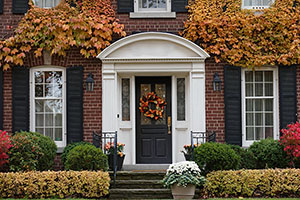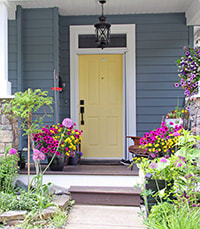 Today’s housing market is very different from the 2008 housing crisis. At the NAR Real Estate Forecast Summit, NAR Chief Economist Lawrence Yun highlighted the four key reasons why home prices are expected to remain steady in 2023. Job Market During the last recession, 8 million jobs were lost in just one year. However, in the current labor market, there hasn’t been a lot of job losses. While layoffs in the technology and mortgage industries have been making headlines, there has not been enough of an accumulation to form a net job loss, according to Yun. Subprime Mortgages Back in 2008, subprime loans were quite common. The abundance of subprime loans—loans offered to buyers with poor credit—contributed to the housing bust. Yet in today’s market, subprime loans are nearly nonexistent. Nationwide Housing Shortage In today’s market, only 4.6 million new homes are being constructed. For the past decade, the housing market has experienced a severe lack of inventory, due in part to underproduction in the new-home sector. Low inventory levels have led to increases in home prices, a trend that is expected to continue. Foreclosures During the last housing crash, many homeowners had to walk away from their loans as home prices collapsed. In today’s housing market, the percentage of homes in foreclosure remains at historical lows—around 0.6%. What’s more, Yun predicts foreclosures to remain near these historical lows for the remainder of 2023. Though recent home sales have been slowing, the current housing market is quite different from that of 2008. Home prices remain elevated and inventory is low. As a result, according to Yun, “The chance of a price crash is very small due to the lack of supply.”
0 Comments
 Interest rates are always changing, and it can be hard to predict when they’ll go up or down. Here are some ways higher interest rates have affected the housing market. A Balanced Market Home prices are still up compared to last year, but most experts agree that home prices have peaked and are starting to adjust in many markets. Ultra-low mortgage rates brought a large number of buyers into the market, which drove up property prices as buyers competed for available homes. The increasing mortgage interest rate has priced many buyers out of the market. With fewer buyers shopping for homes and inventory increasing in some markets, sellers are beginning to adjust their asking prices to help prospective buyers afford the monthly interest and principal. Less Competition Buyers bemoan the higher monthly payments and reduced budget that come with a high-interest rate, but the flip side of this is that it gives them more leverage in negotiations. The bottom line is that rising interest rates price more buyers out of the market and motivate investors to stay on the sidelines for now. This means that instead of going up against 10 offers, buyers have a chance of being first in line. More Negotiating Power Buyers who can afford to stay in the game have more ground to stand on. Gone are the days of waiving contingencies and inspections. When sellers are more motivated, buyers are able to make reasonable or reduced offers—and even negotiate credits or repairs. This is a huge change from the market frenzy that occurs with ultra-low interest rates. For the right buyer, now may be the perfect time to get into the market before interest rates rise further. Buyers, interest rates are much higher than the rock-bottom rates of the last few years, but they are still historically low. Now is the time to secure a skilled real estate agent to start shopping. Sellers, you can still get a good price for your home, but be prepared to make concessions, such as rate buy downs or even helping with closing costs.  Fixer-upper homes are attractive for many reasons, including a lower sales price, less competition, and a relatively higher potential for resale profit. However, just like any other investment, there is risk involved in it. For one, fixer-uppers, which entail more added costs for repair and remodeling, can quickly become a bad investment. Avoid having your dream house turn into a nightmare by identifying the thin line between a fixer-upper and an outright bad investment. Condition | A fixer-upper requires mostly cosmetic improvements, while a bad investment requires both cosmetic and general structural improvements. Ideal fixer-uppers are those that need mostly cosmetic enhancements: paint jobs, floor refinishing, new lighting fixtures, and remodeled kitchen and bathrooms—everything that appeals to the eye. Certain structural improvements cannot be avoided, such as roofing, the heating and cooling system, and electrical wiring. On the other hand, a bad investment requires much more work, possibly to the structure or foundation, plumbing, or a terrible layout. These problems would require much higher costs than the amount you saved from buying it. Location | A fixer-upper is usually located in a desirable neighborhood, while a bad investment is on a busy street in an unsafe area. One of the strongest indications of a house’s market value is its location. Avoid buying fixer-uppers on a busy street, near a construction site, or in any other disruptive location. A wrong location for a fixer-upper significantly reduces your profit potential. Take note that you can improve only the house, not its position. After-Repair Appeal | A fixer-upper is a home everybody will love (and intend to buy) after you have made all repairs and renovation, while a bad investment is a house that, for some reason, nobody will want to buy, no matter how perfect it looks. There are numerous situations when a fixer-upper could be a bad investment. For example, few people want to buy a house with just two bedrooms in a neighborhood of mostly three- to four-bedroom homes. Or the problem could be location-related: The house may be near a river that overflows during heavy rains. The reason may also involve the layout, such as westward-facing windows that don’t get much sunlight. Avoid buying old houses with problems you cannot fix after a moderate renovation. A fixer-upper versus a bad investment could be hard to distinguish—consider the condition, location, and after-repair appeal. If you have questions about buying or selling real estate, reach out today!  In uncertain times, it’s natural to look for ways to ensure our financial security. One option that can provide peace of mind is investing in real estate. Here’s how real estate investing can help provide financial security. Buying and selling real estate to make a profit is one of the oldest and most reliable ways to build long-term wealth. Real estate investments can be as simple as buying a property and renting it out, or as complex as developing a property. The key to success in real estate investing is finding sound investment opportunities and making smart decisions. With the current market conditions, now is a good time to start thinking about buying real estate. Here are some of the benefits of owning and investing in real estate: • Real estate is a tangible asset that can be used as collateral for a loan. • Real estate is a stable investment that historically increases in value over time. • Real estate rentals can provide passive income to supplement your income or retirement savings. Investing in real estate allows you to build equity in an asset that can be used as a source of funding for other investments or life goals. You can tap into equity by taking out a home equity loan or home equity line of credit (HELOC). One of the reasons real estate makes a great investment is because it’s an easily accessible asset you can see and feel, unlike stocks or other investments. It also has a low correlation with the stock market, meaning it’s not as volatile. Another great thing about real estate is you can use it for your own enjoyment, such as staying at a vacation home you rent out for most of the year. Remember, real estate appreciation is a proven way to make money in the long run. When you invest in a property, you’re investing in yourself and your future.  There's nothing quite like sinking into a comfy seat with a mug of your favorite drink and making small talk with a good friend. If you’re looking to create a relaxing, cozy conversation area, consider these four ways you can transform your living room. Whether you have a studio apartment or a sprawling estate, these design options can accommodate any home. U-shape | In a traditional U-shaped conversation area, the three sides of the U are formed by sofas, love seats, settees, or armchairs. The open end of the U is reserved for the focal point, such as a stunning fireplace, television, or a large window. Try placing a large square ottoman in the middle of the U at equal distance between the furniture pieces. You’ll want to leave enough space to pass between each sofa, love seat, or chair—about 22 inches. End tables placed between two armchairs or other seating are a great option to hold table lamps, pots of greenery, or beverage containers. Square Configuration | For the square-shaped design, furniture seating takes up all four sides of the conversation area. For smaller homes, place two love seats opposite each other and two armchairs facing one another to create the square. Situate a large round coffee table in the middle of the conversation area to hold your reading materials, a vase of flowers, or electronic devices. Make sure the coffee table is at least 18 inches from each of the seats. Last, try adding two end tables diagonally across from each other between the love seats and armchairs to hold table lamps. Parallel Sofas | This arrangement is created by positioning two identical sofas across from each other; it’s an especially useful design if you want an open walkway at each end of the sofas. Situate an oval or rectangular coffee table between the two pieces of furniture, not extending more than two-thirds the length of the sofas. Avoid placing a centerpiece in the middle of the coffee table, which will block the view between the sofas. Substitute smaller love seats or settees to accommodate an area with limited floor space. L-shape | An L-shaped conversation area leaves a larger accessible area than the other furniture groupings, working well to make a room seem open and spacious. A sectional sofa is ideal for creating the L configuration, but you can also place a sofa and love seat next to each other to create the L-shape. The interior corner of the sectional sofa is a natural place for an oversized round ottoman. Situate a tray atop the ottoman as a convenient spot to place drinks or snacks. If you are floating the sectional in the middle of a room, leave a three-foot clearance for major walkways in your home. Consider these four furniture layouts to create a comfortable, fun conversation area in your home. Choose the grouping that best suits your personal preference and physical space to enjoy time with friends and family to the fullest.  For the sixth month in a row, existing-home sales declined, according to the National Association of Realtors (NAR). What’s more, every sales region in the country reported both month-over-month and year-over-year decreases. The drop in home sales was likely due to mortgage rates rising to 6% in early June. According to NAR Chief Economist Lawrence Yun, any decrease in mortgage rates would give an additional boost of purchasing power to homebuyers and help stabilize the market. Price Growth Slowing Another market indicator that could boost homebuyers is the peak of home selling prices appears to have passed. The median existing-home price in July increased 10.8% from a year earlier, with every sales region posting price gains. Though prices have seen year-over-year increases for the past 125 consecutive months, prices declined $10,000 from June’s record-high price of $413,800. Inventory Increasing The decline in home prices from June to July can partially be explained by an increase in supply. By the end of July, total housing inventory reached 1,310,000 units, up 4.8% from a month earlier and unchanged from a year earlier. At the current sales pace, this level of inventory would supply the market for 3.3 months, up from only 2.9 months in June and 2.6 months in July 2021. Though inventory may be starting to increase, Yun still sees signs of a housing recession in terms of declining home sales and home building. “However,” he added, “it’s not a recession in home prices. Inventory remains tight and prices continue to rise nationally with nearly 40% of homes still commanding the full list price.” Home Sales Declining Existing-home sales fell 5.9% from a month ago and 20.2% from a year ago. This drop in demand from homebuyers may result in some sellers being more motivated for a sale. Yet despite declining demand, properties sold in record time in July. The average property remained available for sale for just 14 days, unchanged from June and down from 17 days in July 2021. This set a record, as homes haven’t sold at a pace this quick since NAR began tracking days on market back in May 2011. Of all the homes sold in July, 82% were on the market for less than one month. Regional Breakdown Northeast: Existing-home sales annual rate of 620,000; a decrease of 7.5% from June 2022 and 16.2% from July 2021. The median sales price of $444,000 increased 8.1% from July 2021. Midwest: Existing-home sales annual rate of 1.19 million; a decrease of 3.3% from June 2022 and 14.4% from July 2021. The median sales price of $293,300 increased 7% from July 2021. South: Existing-home sales annual rate of 2.13 million; a decrease of 5.3% from June 2022 and 19.6% from July 2021. The median sales price of $365,200 increased 14.7% from July 2021. West: Existing-home sales annual rate of 870,000; a decrease of 9.4% from June 2022 and 30.4% from July 2021. The median sales price of $614,900 increased 8.1% from July 2021.  When applying for a mortgage, it’s important for would-be homebuyers to be aware of the factors, both positive and negative, that could affect their ability to get a loan. Any steps you can take to accentuate the positive and resolve negative financial issues will be a plus in the eyes of the potential mortgage lender. Positive Factors Some factors that may help you get the mortgage loan you need include:
Some things that could harm your chances of getting the mortgage you need include:
 Increasing mortgage rates and high inflation are taking a toll on the housing market. In March, existing-home sales decreased for the second month in a row, according to the National Association of Realtors (NAR). Year-over-year sales were down in every sales region in the country, while the West was the only sales region to not record a drop in month-over-month sales. Mortgage rates are expected to climb higher throughout the year; as a result, Lawrence Yun, chief economist for NAR, predicted that sales transactions should contract by 10% this year. Prices Higher Year over Year Prices are also expected to readjust throughout the year, which should come as welcome news to buyers. The median existing-home price for all types of housing increased 15% year over year. Every sales region recorded price increases. What’s more, March marks the 121st consecutive month of year-over-year increases, besting last month’s record. The lack of available inventory remains a factor in the price gains. However, “sellers should not expect the easy-profit gains and should look for multiple offers to fade as demand continues to subside,” stated Yun. The average property remained available for just 17 days in March, down from 18 days in both February and March 2021. Of all the homes sold in March 2022, 87% were available for under one month. More Homes Needed Although improving, total housing inventory remained low in March; there were 950,000 units available for sale, up 11.8% from February but down 9.5% from March 2021. At the current sales pace, this inventory level would supply the market for only two months, up from 1.7 months in February but down from 2.1 months in March 2021. All-Cash Sales Climb “With rising mortgage rates, cash sales made up a larger fraction of transactions, climbing to the highest share since 2014,” according to Yun. All-cash sales represented 28% of all transactions in March, up from 25% in February and 23% in March 2021. First-time buyers accounted for 30% of all transactions in March, up from 29% in February. According to the NAR 2021 “Profile of Home Buyers and Sellers,” the annual share of first-time buyers was 34%. The demand from first-timer buyers could be driven by the desire to lock in at the current mortgage rate before rates go higher. Individual investors and second-home buyers—two groups who account for many all-cash sales—were responsible for 18% of all purchases in March, down from 19% in February but up from 15% in March 2021. Regional Breakdown Northeast: Existing-home sales annual rate of 670,000; a decrease of 2.9% from February 2022 and 11.8% from March 2021. At $390,200, the median sales price increased 6.8% from March 2021. Midwest: Existing-home sales annual rate of 1.27 million; a decrease of 4.5% from February 2022 and 3.1% from March 2021. At $271,000, the median sales price increased 10.4% from March 2021. South: Existing-home sales annual rate of 2.62 million; a decrease of 3% from February 2022 and 3% from March 2021. At $339,000, the median sales price increased 21.2% from March 2021. West: Existing-home sales annual rate of 1.21 million; unchanged from February 2022 but a decrease of 4.7% from March 2021. At $519,900, the median sales price increased 5.4% from March 2021.  Most consumers are familiar with the concept of house flipping, thanks to a variety of reality shows. Smart, seasoned investors will renovate a house to be move-in ready and then sell at tight profit-margins to make a quick sale. But how does a buyer know if a flipped home is a solid buy or a real rip-off? When it comes to buying a flipped house, asking these three big questions will help ensure you don’t "flip out." 1. Can I get a Copy of the Property History? As a buyer, it’s wise to find out how many times the home has been sold in the past, as well as the history and prices of those prior sales. Incredibly low sales prices can indicate there is more wrong with the property than what meets the eye. Invest in the help of a seasoned real estate professional to help you acquire crucial property history information before submitting an offer. In full disclosure states, the law requires for buyers to be provided with a statement from the seller releasing property information for the past several years. However, not all states are full disclosure states, so it pays off for buyers to get to know real estate law for their local area. 2. What Renovations Have Been Done? The saying "beauty is only skin deep" can be applied to flipped houses too. Some investors will only spend enough money to renovate the cosmetic interior of the house, but ignore major repairs for serious structural problems. Investors who do this are hoping to rope in a buyer and get out of the deal with cash in hand before anyone is the wiser, making a property like this a bad investment. Buyers should hire their own home inspector to evaluate the condition of the home before submitting a contract to purchase. Inspections not only evaluate the condition of completed repairs, but also what bigger problems might be lurking underneath the surface. 3. Do You Have Permits? Good investors will obtain permits for any work done on a property more complex than a cosmetic facelift. If permits do not exist, this can cause issues with closing on a property and can result in additional fines if buyers enter into a home purchase contract sans required documentation. Seek out professional legal and real estate advice; call your local city municipal office to find out what work requires a permit and what doesn’t before buying a flipped house. A flipped house could be a solid buy, or it could be a cosmetically appealing home disguising larger unseen issues. Buyers should approach these home sales with caution and verify all documentation.  First impressions mean a lot—especially when it comes to your home’s curb appeal. Whether you’re getting ready for resale or just want to update the exterior, you may be thinking your home is ready for a curbside makeover. Here are some ideas to maximize your home’s curb appeal: Is Your Home Photogenic? The best way to look at your home through the eyes of a potential buyer is to take pictures of it. Take one from directly across the street and others from angles on both sides of the home. Honestly compare your pictures with those of comparable homes online. Make a list of what could be improved. The Power of Pressure Washing Nothing says, “I care about my property,” more than cleanliness. And pressure washing works wonders. Wash the front of the home along with the garage doors, driveway, and sidewalk. If your home’s paint job is looking dingy, you may find that pressure washing eliminates the need for new paint. Or you may find that painting the trim is the only touch-up you need. A pressure washer can be rented from a big-box home improvement store. Let the Light In! Sparkling clean windows invite visitors to look inside your house and offer those already inside the home a view of your beautiful landscaping. If your home is several stories high, you may need to hire a professional window cleaning service. Some services also include gutter cleaning. Focus On Your Front Door Give the front door a fresh coat of paint to make it look truly inviting. In addition, polish or replace all metal pieces, such as door knockers and kick plates. New house numbers are another easy way to make your porch look polished. Think about adding blooming flowers for spring and summer and a wreath on the front door to add a welcoming look. Finally, if the front porch lighting looks dated, upgrade to new fixtures. Trim Untidy Trees and Shrubs Many homeowners become accustomed to overgrown shrubs and ornamental trees. But overgrown vegetation effectively hides your home from view. It never hurts to remove too-big plants and replace them with trendy bedding options. Fresh Mulch Makes Flower Beds Look Better Even if your flower beds have mulch, add more and don’t be stingy. New, thick mulch makes a so-so planted area look like a professionally maintained one. For an even more manicured look, add some edging material. |
AuthorA variety of pertinent real estate topics and tips from various authors and contributors. Archives
December 2024
Categorieshow much home can i afford?*
|


